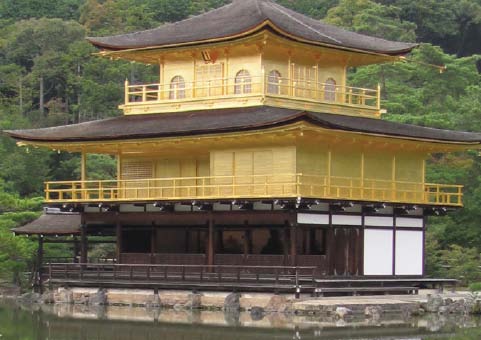
Text and Photos by Susan de la Fuente.
Almost a year has passed since our visit to Japan. We managed to fit in our week-long trip last October before the earthquake and the nuclear upheaval that ensued. We flew from Shanghai to the southern part of Japan. Kyoto is a convenient base for viewing traditional aspects of Japan, as it was the imperial capital prior to World War II. Compared to China, we found the atmosphere calmer and the crowds less dense.
On arrival in Kyoto we received helpful information from two charming seniors staffing the tourist office outside the train station. They referred us to a service in the same building that books hotel rooms at discounted prices. Our Kyoto hotel provided a neighborhood map indicating the location of nearby supermarkets, trams and internet cafes.
On our walks around town we discovered that driving is on the left, and protocol and ritual still count in Japan. Bowing is an important part of greeting, while leave-taking may require a succession of dignified bows. The occasional glimpse of a kimono was a novelty to us. Most beautiful is the sight of a formal wedding party — the mothers in black silk kimonos with gold embroidery, the fathers in morning coats, and a resplendent bride and groom. Small flower-festooned shrines outside private homes are a common sight, as are school uniforms with jackets and ties. Tourists who are brave enough to try a local spa are closely escorted to ensure they observe all regulations properly: shoes off, slippers on, or just plain bare feet.
Cherry blossom season and fall foliage are prime times to visit. Though we missed the cherry blossom, we appreciated the immaculately maintained gardens of Kyoto, which are landscaped as either wet or dry gardens. Wet gardens center round a lake or pond that represents the ocean. Rocks jutting from the water are figurative islands, and the pebbly borders symbolize a beach area.
In the garden surrounding the Rokuonji Temple — known as the golden temple, and a World Heritage site — the reflection of the golden roof on the green lake was remarkable. Trees added their darker reflection to the surface of the water, while the hills beyond are the borrowed landscape that adds depth to the scene, like the frame of a picture. We admired small stony islands with bonsai trees and mossy areas of the park surrounding more majestic trees. Another day we visited the most famous dry garden in Japan, which impressed with its stark simplicity, featuring unusually shaped granite rocks set off by a bed of fine white gravel. It was a far cry from the herbaceous borders of English country gardens.
Kyoto offers a free tour of royal palace buildings and their grounds. Allow time to queue for tickets, as latecomers are not admitted. As we gathered, a friendly “Shalom” rang out and we met an Israeli couple hailing from Ramat Hasharon. The gilt-edged palace roofs consist of multiple layers of cypress bark that are handcrafted and maintained with Sisyphean effort. The imperial rooms have bamboo mat flooring and are adorned with elegantly painted screens. Weathered stone lanterns decorate a rocky island on the palace lake. As we left by the landscaped route, we glimpsed a lone crane and two white ducks on the water.
Wrapped up in our ponchos one rainy morning, we chanced upon the monthly flea market in the town center. After lunch in a small park we attended a fashion show of silk and brocade kimonos. Upstairs, artisans elaborated hand embroidery and sold their wares.
Early Friday morning we visited Arashiyama, a half-hour trip to the west of Kyoto, arriving in a one-car electric trolley. From the station we walked uphill past the garden of a venerable temple and followed a trail through a beautiful bamboo forest. This area, called the Okochi-Sanso Garden, provided a splendid view of the river as we reached the summit of the hill and moved downwards through leafier trees. I recalled a fragment from Andrew Marvell’s The Garden, “a green thought in a green shade,” on viewing this splendid green-on-turquoise vista.
We then followed a nature trail along the opposite river bank, its signs promising a great view and including Japanese style reflections. “Mount delights, water laughs” was one of them. Though the rowboats plying the river with bamboo staves tempted us, time was too short. Our visit concluded at a small foot spa on the station platform where the shallow 150-year old footbath is fed by hot sulfur springs.
Next we headed for the port city of Kobe for a fascinating Shabbat with the Jewish Community of Kansai. Kobe had small groups of Jews, both Sephardi and Ashkenazi, throughout the twentieth century. They assembled for prayer in private homes mainly on Sabbaths and festivals. A few built mikvaot in their homes that they opened to the community.
A prominent Sephardic leader was Rahmo (Rahamin) Sassoon. Born in 1912 in Aleppo, Syria, Sassoon arrived in Japan in 1936 and set himself up as an independent businessman. In 1939 he established Ohel Shelomoh, named for his father, in a rented building. Both Sassoon and Nissim Tawil were active in the war years on behalf of the Jewish refugees in Kobe and liaised with the Japanese government. After the war Sassoon went to Europe in search of a Syrian Jewish wife. The family relocated to New York in 1964 but still maintain ties with the Kobe community.
The Jewish population reached its height during World War II. At that time most Polish-Lithuanian refugees en route for Shanghai took the Trans-Siberian railroad to Vladivostok, continuing by boat to Kobe or to Yokohama. A total of 2,185 penniless Jewish refugees arrived in Japan between August 1940 and June 1941 and spent several months there. At least 400-500 of them belonged to the Mir yeshiva. The existing Ashkenazi community of Kobe, consisting of less than 30 families, was particularly active in coordinating a massive effort to help the refugees escape from Lithuania and to meet their many needs after arrival. Some leaders of Jewcom, as the Ashkenazi community was called at the time, were Anatole Ponevejsky, Moise Moiseeff and Leo Hanin. Their community buildings were turned into refugee centers. The bulk of financial support came from the Joint and HICEM with some local participation.
Among the refugees in Kobe were such personalities as the Amshenower Rebbe, Rabbi Kalish, the Zionist Zerach Wahrhaftig and the future industrialist Shaul Eisenberg. Although the Japanese regarded the orthodox Jews among the arrivals as an exotic element, they were sympathetic to their plight and did not question their dubious entry visas. Some bribery was no doubt involved as the community blog indicates http://historyofjewishkobejapan.blogspot.com/2009/11/hi.html.
The blog includes some memorable anecdotes of this period. Not surprisingly, the Ashkenazim refused to eat rice on Pesach, so truckloads of potatoes were brought in for them. Another tale relates how a minyan of yeshiva students gathered for prayer on the rooftop of a department store overlooking the harbor. Since war preparations were then in full swing, a contingent of police was called in to investigate the gathering. Perhaps the black boxes the Jews had attached to themselves were cameras? After an interpreter explained that the boxes were not cameras, but tefillin, they were simply asked to pray on a lower floor.
By September 1941, 1,100 Kobe refugees were relocated to Shanghai, and towards the end of the war most of the local Ashkenazim had also moved on. After its attack on Pearl Harbor on December 7, 1941, Japan restricted international trade, which adversely affected the Jewish traders of Kobe. Kobe was heavily bombed during the war, and over the years the dispersed community gradually dwindled.
Nowadays, the synagogue has a new young rabbi and rebbitzen from Israel, Rabbi David Gingold and his wife Nili. Its present building, Ohel Shelomoh, was consecrated in 1970 to replace Rahmo Sassoon‘s warehouse building where services were held after the war. The Sassoon and Kadoorie families were the major donors of the new building.
The community now consists mainly of expatriate Sephardic Israelis. It is a small, friendly group with around 30 active members who show a genuine desire to maintain a Jewish connection. Most of the men are married to Japanese women who are, in some cases, halachically converted.
Ohel Shelomoh’s communal Shabbat services and meals are well attended by members and tourists every weekend. Moshiko Suissa cooks, bakes challah and handles hospitality. As the area of Kansai includes five prefectures (Nara, Wakayama, Kyoto, Osaka, and Hyogo), there is no possibility of daily services. Jack Yohay issues an online bulletin in English to all members, near and far, to update them on events.
During the meals, which were Israeli style with lots of salads, we met members of the congregation. One American medical student spent every Shabbat there during his year overseas. I spoke with an American Jewish woman, an English teacher who was widowed from her Japanese husband. She spoke fluent Japanese and complained that the waiter spoke impolitely to her and must be Chinese. She was right about that!
Although fish, vegetables, fruit and rice are available in Japan, Kashrut is no simple matter. Rabbi Gingold explained: “Shehita or ritual slaughter is forbidden by law. Imported products from the USA are spread throughout a wide array of import stores. We even have a list of stores and what kosher products can be purchased there, but some carry only one product.” He is investigating how to lower the price of the kosher products and increase the choice of products available. Halav Yisrael or supervised milk is also imported after attempts to obtain it locally were unsuccessful. His wife refers to her new environment as “an experience that is both challenging and character building.”
As for lifecycle events in this far flung community, Rabbi Gingold notes: “We haven't experienced any since we've been here. However the next barmitzvah is to take place in another 11 months.” Regarding Jewish education, he said, “Thanks to Hashem we have been very successful in building new infrastructures for the adult education in our community.” But as the Jewish school originally situated in the synagogue complex no longer exists, children's education is much more problematic. “Our older daughter, Noyah, shows the real need for a school system similar to the one she left in Israel and cannot find a Japanese alternative. This too makes education an extremely complex issue, in the near future at least.”
As the rabbi states on the community website: “The Jewish Community of Kansai is one of the world's warmest and most hospitable synagogues. Nobody who visits is a guest. All who come are welcomed as family. It is our pleasure to invite you to visit and/or attend Shabbat and holiday services.”
It is certainly comforting to find this small outpost of Judaism in a country where people still prostrate themselves in front of statues. My husband, Mordechai, puts it this way: “Everywhere you go in traditional Japan there are shrines and temples. I recently studied the tractate of Avodah Zarah (Idol Worship) and learned many things that sounded obsolete to me. However, after visiting Japan I see that some of these practices are still going on. Perhaps the ritual hand washing believers do has a Jewish source. However, their practice of ‘awaking the spirits’ by making noise — clapping and bell-ringing — was derided long ago by Elijah the prophet.” [‘…perhaps he’s sleeping and must be awakened,’ Kings 18, 27].
After wishing the Gingolds success in their endeavors, we departed for Hiroshima on Sunday morning. The bullet train or shinkansen glides along smoothly, almost like an airplane, crossing the whole of Japan in about five hours. After a brief trip to the isle of Miyajima that rainy day, we returned to the sobering sights of Hiroshima, once the military supply center of the Japanese. The Peace Park, Memorial Museum and burned-out dome of mangled metal alongside the river are grim reminders of World War II. After our museum visit, some sixth-graders from Minagidai School interviewed us for their project. As part of this rapprochement activity, they offered some origami that they had made (a crane, a flower, a cicada and a monkey) and we photographed one another. This friendly meeting with innocent children was our farewell to Japan.

 End of Year Event - Hefzibah, Netanya
End of Year Event - Hefzibah, Netanya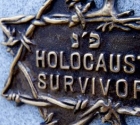 Additional 1-time Payment to Survivors who worked in the Ghetto
Additional 1-time Payment to Survivors who worked in the Ghetto ITAMAR MAKES FRIENDS - A Review
ITAMAR MAKES FRIENDS - A Review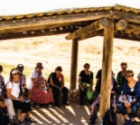 From Bible to Bedouins and Battles
From Bible to Bedouins and Battles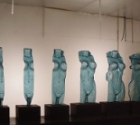 Trip to the Dead Sea
Trip to the Dead Sea Japan
Japan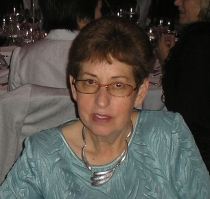 Susan de la Fuente
Susan de la Fuente